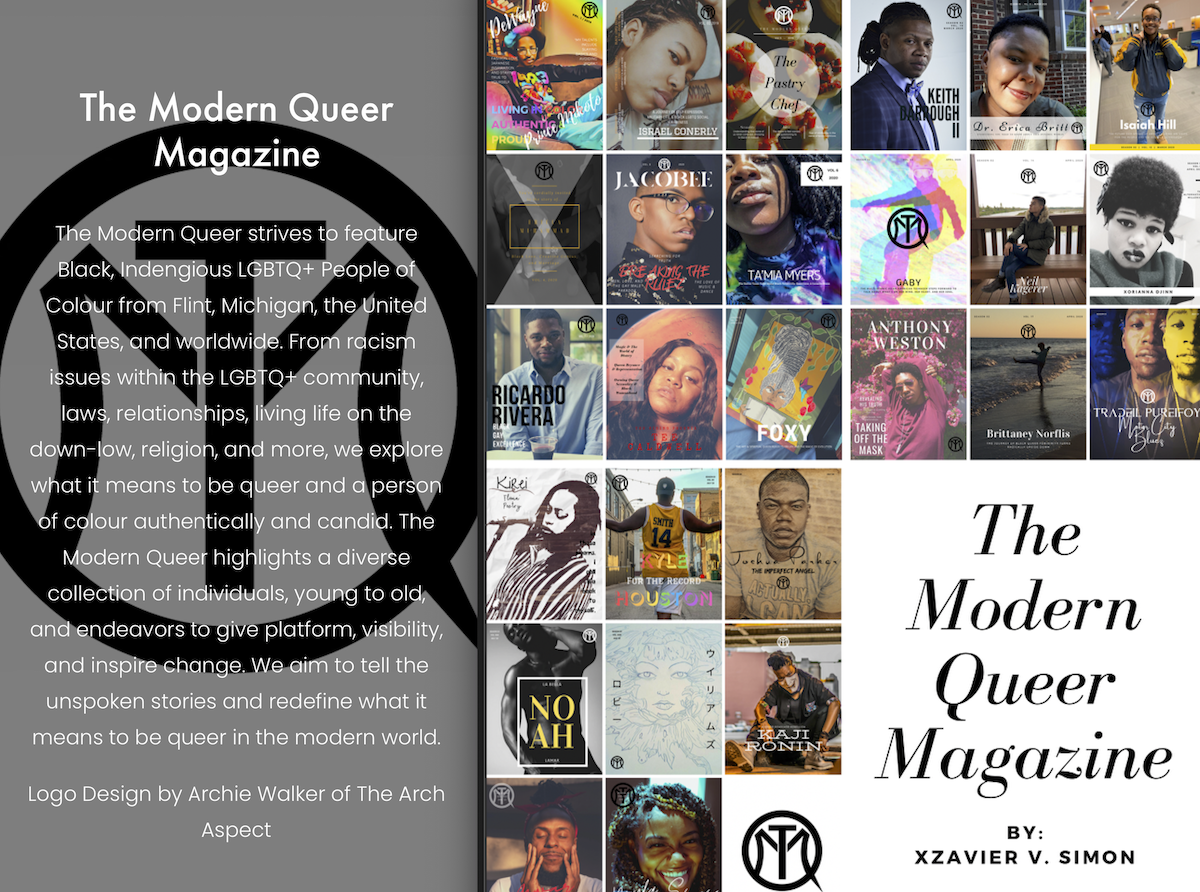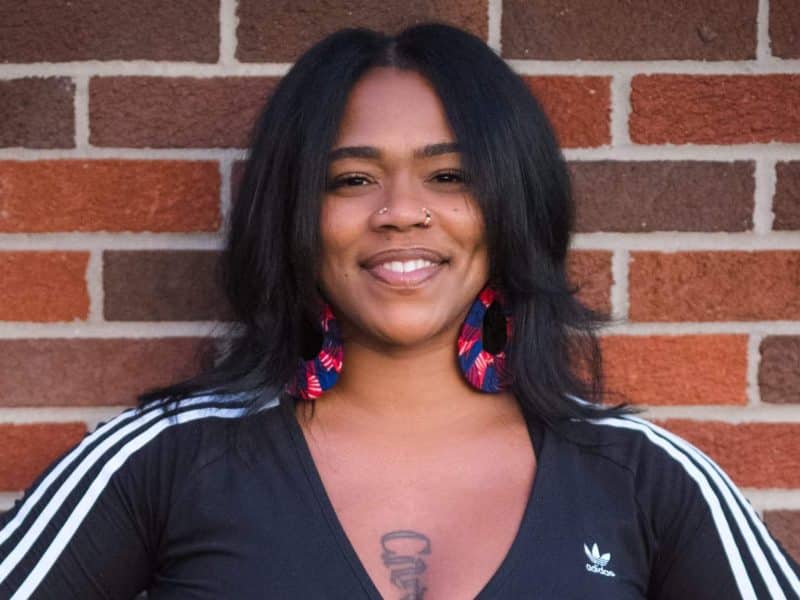Flint native chronicles stories of the Queer community with reverence, care
The Modern Queer, published by Xzavier Simon, is only a year old with 4 seasons, an international readership, and over 4,000 views.
FLINT, Michigan — Xzavier Simon, 30, has mastered a practice that has given most legendary artists current and posthumous admiration. It’s an ability to find the inner-anchor of their intuition that allows them to brave the cliff of creativity and fly by the seat of their pants. Simply put, Simon embodies leading with his passions and asking questions later.

As a result, he has self-published seven books and frontiered Flint’s first digital magazine, the Modern Queer, that features the dimensionality of the queer community. The Modern Queer is only a year old with 4 seasons, an international readership, and over 4,000 views. Oh, he also manages to find a way to cover Flint’s music scene for Flintside as well the nuances of K-pop music in other online articles. Writing is the medium that fills in the gaps with what matters to Simon, and that’s what makes him a trendsetter.
“I wanted to write and create something that told the journey of a Black queer man in America, who’s dealing with and healing from trauma. I still do and am,” he said.
Simon defines himself as a man with a fluid identity—something expansive and without limits like the blank pages he faces every time he writes something new. He explains that this realization was something he had to grow into and part of that was embracing his own unique path with all its detours and roundabouts.
“Doing this magazine made me aware that there were aspects of myself I needed (to be) validated,” Simon said. “There were pieces of me needing to be accepted. I don’t mean just in the aspect of my sexuality, but in terms of my understanding and acceptance of my version of Blackness and my masculinity.”
Despite being born in Flint, Simon is a Beecher native and the third of four brothers. He remembers when he was more extroverted but with moving and changing environments, he found more comfort in turning inwards, where cartoons and video games were his trusted companions. There weren’t many kids in his new neighborhood, so there were fewer ears he could turn to give voice to the complex thoughts that took root in his young mind, until one day his mother gave him an empty book that would change his life forever.
“It’s one of the few moments my mother acknowledged that aspect of my life in a genuine way,” he said. “That journal became my lifeline. I journaled every day about girls I liked, boys I wanted to be with, family trauma, thoughts on God, religion, life, all at the age of nine. I’d say that led me to writing.”
The memory has stuck with him. Along the way Simon was spurred on by enthusiastic English teachers, encouraging friends, relationships, and the works of Ta-Nehisi Coates, Denzel Smith, and James Baldwin. Over the years, it all culminated into his first published book One Way Alley in 2015, just a couple of years before he would leave Michigan to travel.
Traveling was a way to turn a new leaf. His early twenties and time at the University of Michigan-Flint led him to education. He taught youth in the city through after school programs and substitute teaching before moving on to start his own nonprofit that taught mediation from 2014 to 2016. Deep down, he sensed that a greater change was needed and deployed himself to find it. He quit grad school in 2016 and in 2017 Simon journeyed his way through Ohio, Kentucky, Tennessee, West Virginia, Virginia, and North Carolina. He reveled in newfound freedom and experiences before settling into Washington D.C. where he taught classes at Georgetown University for two summers. He continued to release self-published works throughout his years away from Michigan.

When he came back to the Flint area in 2019, he returned with fresh eyes and a new vision—one attuned to the lack of curiosity of the Queer community. Without knowing exactly how he would do it, he started reaching out to friends in his social media network, sleuthing through their timelines for any changes that would indicate a theme or dynamic story to tell. Each issue is a bare retelling of questions and answers between Simon and his subjects, recorded with reverence and care.
“Making the first volume was like, ‘Yeah, I’m really doing this.’ I couldn’t say I didn’t want to do it or get scared,” he said. “In my hands were the lives of eight different people who trusted me to tell a piece of their stories. Even if nothing came out of it. I at least had to keep the promise I made to them.”
Some issues are the result of whittling down 6-7 hour interviews. His writing process is often cradled into the night with the drone of a fan and the lullaby of lo-fi Hip Hop beats. Sustained by a combination of protein shakes, water, and tea, Simon transcribes everything before deciding which portions will make it into the magazine. Then, he arranges it all with visuals in Canva before releasing it on social media.
When there is a need you desire to fill, said Simon. Money, resources, or time aren’t really excuses. You either do it or you don’t.
“When we want to start something, oftentimes we say we don’t have the money, or the resources, or the time, or whatever else. Before we begin we’ve already spoken about it in defeat,” said Simon. “One of the things I love about being Black, is that my people have created incredible things out of, with, and from nothing … I think the reason why I’m the first to do it is because what I wanted to see was ultimately a reflection of myself.”
For Simon, writing itself is a self-aware, excavation process. As he continues to interview he learns more about others that illuminate aspects of his own identity. His voice continues to grow, and he finds more ways to share it.
“Expanding this to look at my own life, I tend to live in the niches—the spaces in-between spaces or underneath the surface,” he said. “I am Black. I am queer. I love Asian culture. I live a very spiritual life and lifestyle. The list goes on. My existence holds niche experiences or things that aren’t very mainstream. Because of this, I can do and create the things that I do.”
Recently, Simon announced his new project on social media on February 12: Conversation with Flint: Notes, Articles, & Interviews. It will be a compilation project containing his Flintside music profiles and newer personal essays.
To find more of Simon’s work and the new upcoming issue of the Modern Queer magazine, visit his website.
“I wanted but never imagined Flint would care for something like this,” Simon said. “It’s wild that people ask to be a part of this. I know I’m destined for something—whether it’s this, books, or whatever else.”
Transparency note: Alexandria Brown is a photographer for the Modern Queer Magazine.








